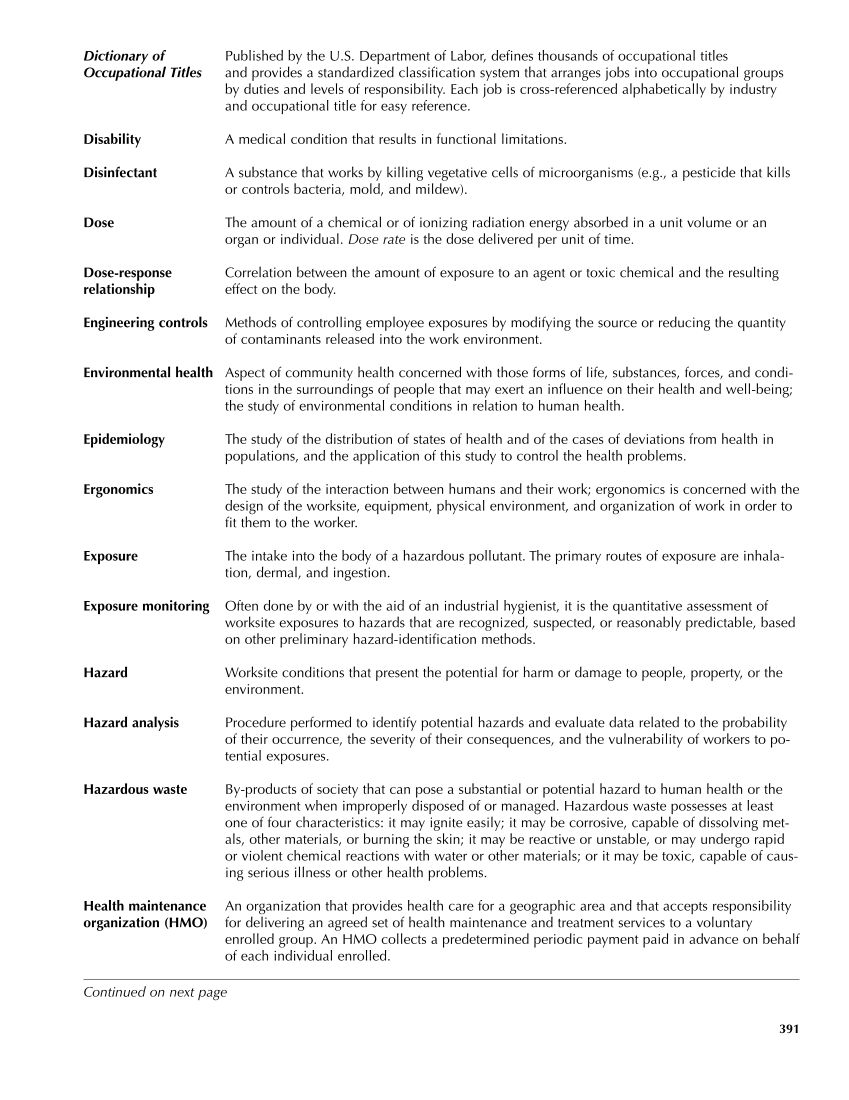Dictionary of Published by the U.S. Department of Labor, defines thousands of occupational titles Occupational Titles and provides a standardized classification system that arranges jobs into occupational groups by duties and levels of responsibility. Each job is cross-referenced alphabetically by industry and occupational title for easy reference. Disability A medical condition that results in functional limitations. Disinfectant A substance that works by killing vegetative cells of microorganisms (e.g., a pesticide that kills or controls bacteria, mold, and mildew). Dose The amount of a chemical or of ionizing radiation energy absorbed in a unit volume or an organ or individual. Dose rate is the dose delivered per unit of time. Dose-response Correlation between the amount of exposure to an agent or toxic chemical and the resulting relationship effect on the body. Engineering controls Methods of controlling employee exposures by modifying the source or reducing the quantity of contaminants released into the work environment. Environmental health Aspect of community health concerned with those forms of life, substances, forces, and condi- tions in the surroundings of people that may exert an influence on their health and well-being the study of environmental conditions in relation to human health. Epidemiology The study of the distribution of states of health and of the cases of deviations from health in populations, and the application of this study to control the health problems. Ergonomics The study of the interaction between humans and their work ergonomics is concerned with the design of the worksite, equipment, physical environment, and organization of work in order to fit them to the worker. Exposure The intake into the body of a hazardous pollutant. The primary routes of exposure are inhala- tion, dermal, and ingestion. Exposure monitoring Often done by or with the aid of an industrial hygienist, it is the quantitative assessment of worksite exposures to hazards that are recognized, suspected, or reasonably predictable, based on other preliminary hazard-identification methods. Hazard Worksite conditions that present the potential for harm or damage to people, property, or the environment. Hazard analysis Procedure performed to identify potential hazards and evaluate data related to the probability of their occurrence, the severity of their consequences, and the vulnerability of workers to po- tential exposures. Hazardous waste By-products of society that can pose a substantial or potential hazard to human health or the environment when improperly disposed of or managed. Hazardous waste possesses at least one of four characteristics: it may ignite easily it may be corrosive, capable of dissolving met- als, other materials, or burning the skin it may be reactive or unstable, or may undergo rapid or violent chemical reactions with water or other materials or it may be toxic, capable of caus- ing serious illness or other health problems. Health maintenance An organization that provides health care for a geographic area and that accepts responsibility organization (HMO) for delivering an agreed set of health maintenance and treatment services to a voluntary enrolled group. An HMO collects a predetermined periodic payment paid in advance on behalf of each individual enrolled. 391 Continued on next page
Purchased from OEM Press by (ge corporate access). (C) 2013 OEM Health Information, Inc. All rights reserved.












































































































































































































































































































































































































































